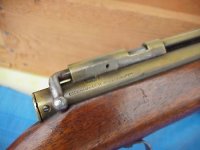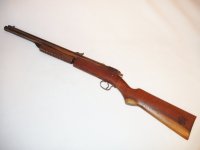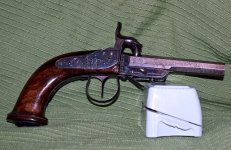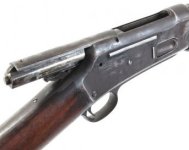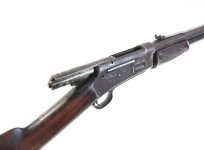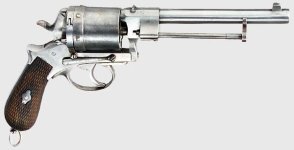You are using an out of date browser. It may not display this or other websites correctly.
You should upgrade or use an alternative browser.
You should upgrade or use an alternative browser.
What the heck
- Thread starter Ozzieman
- Start date
Mike Irwin
Staff
You're on a BB gun kick lately...
That's a Benjamin.
Friend of mine had that exact one when we were growing up. It was his Grandfather's. Unwieldy thing, but it was a lot of fun.
That's a Benjamin.
Friend of mine had that exact one when we were growing up. It was his Grandfather's. Unwieldy thing, but it was a lot of fun.
Yea that 1894 First Daisy BB Gun really got me, been looking for one.You're on a BB gun kick lately...
AND YES I AM NUTS.
You are correct Mike
36 vintage Benjamin franklin bb gun rifle
https://www.youtube.com/watch?v=NbxKqpbkRrY
Attachments
Mike Irwin
Staff
That's exactly what that is. And it's a rather uncommon one, too, I believe, in that it has a full octagon barrel...
Ulrice Congrtatss you got that one.
40 STEVENS HUNTERS PET 1ST MODEL
http://www.oldbike.eu/centurycolumbia/?page_id=460
40 STEVENS HUNTERS PET 1ST MODEL
http://www.oldbike.eu/centurycolumbia/?page_id=460
Mike Irwin
Staff
Yep, the Maynard carbine.
Several different models were made, with some thousands having been issued in the South prior to the start of the war. Those stayed there.
More were made during the War, and those primarily went to cavalry units, including the famous 9th Pennsylvania Volunteer Cavalry.
The Maynard used an externally primed brass case (early versions of the carbine used the Maynard tape primer) with a very large rim. The case could be, and often was, reloaded in the field.
Several different models were made, with some thousands having been issued in the South prior to the start of the war. Those stayed there.
More were made during the War, and those primarily went to cavalry units, including the famous 9th Pennsylvania Volunteer Cavalry.
The Maynard used an externally primed brass case (early versions of the carbine used the Maynard tape primer) with a very large rim. The case could be, and often was, reloaded in the field.
Lets try an oddball pistol.https://thefiringline.com/forums/attachment.php?attachmentid=103732&stc=1&d=1481058897
Attachments
Good one GarandTd
41 MAYNARD CIVILWAR BREECH LOADING PERCUSSION CARBINE
https://en.wikipedia.org/wiki/Maynard_carbine
The Maynard carbine was a breech-loaded carbine used by cavalry in the American Civil War. The First Model was manufactured between 1858 and 1859. About 5,000 were made. In United States service it was distributed to the 9th Pennsylvania and 1st Wisconsin cavalry regiments, United States Marines aboard the USS Saratoga and the United States Revenue Cutter Service. About 3,000 Maynard carbines were in Confederate hands during the war; 5,000 in .35 caliber were purchased by Florida, 650 in .50 by Georgia, and 325 in .50 and 300 in .35 by Mississippi. Around 800 were purchased by militias in South Carolina and Louisiana. The Second Model or Model 1863 was manufactured between 1863 and 1865. Over 20,000 were made. This model lacked the tape primer and stock patchbox, and was used by the 9th and 11th Indiana cavalry regiments and 11th Regiment Tennessee Volunteer Cavalry, among others. The Maynard had a good reputation for long-range accuracy, and Confederate sharpshooters made extensive use of it, especially during the Siege of Charleston.
It was highly praised by the soldiers – Private Toby of the 1st Mississippi Infantry stated that it was "warranted to shoot twelve times a minute, and carry a ball effectually 1600 yards. Nothing to do with Maynard rifle but load her up, turn her North, and pull trigger; if twenty of them don't clean out all Yankeedom, then I'm a liar, that's all."[
Mechanical operation[edit]
When the gun's lever was depressed, the barrel rose, opening the breech for loading. Afterwards the lever was raised to close the gun's breech. Once cocked, the loaded weapon could be primed by either placing a percussion cap directly on its nipple or by using Maynard's priming system to advance a primer to the nipple. The brass Maynard cartridge did not have an integral percussion cap; a small hole in the middle of its base fired it when the external cap was detonated. The cartridge, which had a wide rim permitting swift extraction, was reloadable up to 100 times. This proved to be a significant feature for the Confederate troops equipped with it. Another significant feature was that the use of a metallic cartridge prevented gas escape at the breech, a serious concern for early externally primed breechloaders.
41 MAYNARD CIVILWAR BREECH LOADING PERCUSSION CARBINE
https://en.wikipedia.org/wiki/Maynard_carbine
The Maynard carbine was a breech-loaded carbine used by cavalry in the American Civil War. The First Model was manufactured between 1858 and 1859. About 5,000 were made. In United States service it was distributed to the 9th Pennsylvania and 1st Wisconsin cavalry regiments, United States Marines aboard the USS Saratoga and the United States Revenue Cutter Service. About 3,000 Maynard carbines were in Confederate hands during the war; 5,000 in .35 caliber were purchased by Florida, 650 in .50 by Georgia, and 325 in .50 and 300 in .35 by Mississippi. Around 800 were purchased by militias in South Carolina and Louisiana. The Second Model or Model 1863 was manufactured between 1863 and 1865. Over 20,000 were made. This model lacked the tape primer and stock patchbox, and was used by the 9th and 11th Indiana cavalry regiments and 11th Regiment Tennessee Volunteer Cavalry, among others. The Maynard had a good reputation for long-range accuracy, and Confederate sharpshooters made extensive use of it, especially during the Siege of Charleston.
It was highly praised by the soldiers – Private Toby of the 1st Mississippi Infantry stated that it was "warranted to shoot twelve times a minute, and carry a ball effectually 1600 yards. Nothing to do with Maynard rifle but load her up, turn her North, and pull trigger; if twenty of them don't clean out all Yankeedom, then I'm a liar, that's all."[
Mechanical operation[edit]
When the gun's lever was depressed, the barrel rose, opening the breech for loading. Afterwards the lever was raised to close the gun's breech. Once cocked, the loaded weapon could be primed by either placing a percussion cap directly on its nipple or by using Maynard's priming system to advance a primer to the nipple. The brass Maynard cartridge did not have an integral percussion cap; a small hole in the middle of its base fired it when the external cap was detonated. The cartridge, which had a wide rim permitting swift extraction, was reloadable up to 100 times. This proved to be a significant feature for the Confederate troops equipped with it. Another significant feature was that the use of a metallic cartridge prevented gas escape at the breech, a serious concern for early externally primed breechloaders.
Buzzcook, we have a winner.
I felt stupid when I found this one,,,,, didn't know a Colt slide action was ever made.
42 COLT EXPRESS LIGHTNING PUMP ACTION RIFLE
https://en.wikipedia.org/wiki/Colt_Lightning_Carbine
The Colt Lightning Carbine or Colt Lightning Rifle was a slide-action (pump-action) rifle manufactured by Colt from 1884 to 1904 and was originally chambered in .44-40 caliber.[1][2] Colt eventually made the Lightning Rifle in three different frame sizes, to accommodate a wide range of cartridges, from .22 Short caliber and .38-40 to .50-95 Express.[3] Its profile somewhat resembles the pump-action rimfire rifles made by the Winchester Repeating Arms Company and Remington Arms.[2] The Lightning saw use as a sporting arm in America and was adopted for use by the San Francisco Police Department, but was never as popular or as reliable as the various lever-action rifles of its day.[2]
Variants[edit]
The medium-frame Colt Lightning Magazine Rifle was manufactured between 1884 and 1904.[4] It was the first slide-action rifle offered by Colt.[4] Colt records indicate 89,777 were produced, in calibers 32CLMR (.32-20), 38CLMR (.38-40) and 44CLMR (.44-40) as a companion arm to the Colt Single Action Army revolver.[4] Two versions were offered: a rifle, with a 26 in (66 cm) barrel and 15-rounds magazine, and a carbine, with a 20 in (51 cm) barrel and 12-rounds magazine.[4] The San Francisco Police Department acquired 401 rifles. All had 26 in (66 cm) round .44-40 barrels and bore S.F.P 1 through S.F.P 401 stampings on the lower tang.[4]
The small-frame Lightning (also referred to as "Second Model Colt Lightning"[4]) was the first rimfire rifle made by Colt and was manufactured between 1887 and 1904 as a plinking and gallery gun.[4][5] Colt records indicate 89,912 were made, in .22 Short and .22 Long.[4] Barrel length was 24 in (61 cm) and the rifles had a blued finish, case-hardened hammer, and a walnut stock.[4]
The large-frame Lightning (also called the "Express Model"[4]) was manufactured between 1887 and 1894.[4] Colt records indicate 6,496 were made in different big game calibers such as .38-55 Winchester and .50-95 Express.[4] Barrel length was 22 or 28 in (56 or 71 cm).[4]
Modern versions[edit]
Reproduction Lightning rifles are still manufactured today by companies such as Uberti and Pedersoli for hunting, historical reenactment, and competition purposes such as Cowboy Action Shooting in calibers such as .38 Special/.357 Magnum, .44-40, and .45 Colt.[4] Of these calibers, only the .44-40 was offered in the Lightning when it was originally produced by Colt.
I felt stupid when I found this one,,,,, didn't know a Colt slide action was ever made.
42 COLT EXPRESS LIGHTNING PUMP ACTION RIFLE
https://en.wikipedia.org/wiki/Colt_Lightning_Carbine
The Colt Lightning Carbine or Colt Lightning Rifle was a slide-action (pump-action) rifle manufactured by Colt from 1884 to 1904 and was originally chambered in .44-40 caliber.[1][2] Colt eventually made the Lightning Rifle in three different frame sizes, to accommodate a wide range of cartridges, from .22 Short caliber and .38-40 to .50-95 Express.[3] Its profile somewhat resembles the pump-action rimfire rifles made by the Winchester Repeating Arms Company and Remington Arms.[2] The Lightning saw use as a sporting arm in America and was adopted for use by the San Francisco Police Department, but was never as popular or as reliable as the various lever-action rifles of its day.[2]
Variants[edit]
The medium-frame Colt Lightning Magazine Rifle was manufactured between 1884 and 1904.[4] It was the first slide-action rifle offered by Colt.[4] Colt records indicate 89,777 were produced, in calibers 32CLMR (.32-20), 38CLMR (.38-40) and 44CLMR (.44-40) as a companion arm to the Colt Single Action Army revolver.[4] Two versions were offered: a rifle, with a 26 in (66 cm) barrel and 15-rounds magazine, and a carbine, with a 20 in (51 cm) barrel and 12-rounds magazine.[4] The San Francisco Police Department acquired 401 rifles. All had 26 in (66 cm) round .44-40 barrels and bore S.F.P 1 through S.F.P 401 stampings on the lower tang.[4]
The small-frame Lightning (also referred to as "Second Model Colt Lightning"[4]) was the first rimfire rifle made by Colt and was manufactured between 1887 and 1904 as a plinking and gallery gun.[4][5] Colt records indicate 89,912 were made, in .22 Short and .22 Long.[4] Barrel length was 24 in (61 cm) and the rifles had a blued finish, case-hardened hammer, and a walnut stock.[4]
The large-frame Lightning (also called the "Express Model"[4]) was manufactured between 1887 and 1894.[4] Colt records indicate 6,496 were made in different big game calibers such as .38-55 Winchester and .50-95 Express.[4] Barrel length was 22 or 28 in (56 or 71 cm).[4]
Modern versions[edit]
Reproduction Lightning rifles are still manufactured today by companies such as Uberti and Pedersoli for hunting, historical reenactment, and competition purposes such as Cowboy Action Shooting in calibers such as .38 Special/.357 Magnum, .44-40, and .45 Colt.[4] Of these calibers, only the .44-40 was offered in the Lightning when it was originally produced by Colt.
Attachments
dakota.potts
New member
Gasser M1870 revolver
dakota.potts A winner
48 1870 Gasser Model 1870 Army service
https://en.wikipedia.org/wiki/Gasser_M1870
The M1870 Gasser was a revolver chambered for 11.3×36mmR and was adopted by the Austro-Hungarian Cavalry in 1870. It was an open-frame model, with the barrel unit attached to the frame by a screw beneath the cylinder arbor. The arbor pin was screwed into the barrel unit and fitted into a recess in the standing breech. The cylinder was gate-loaded from the right side, and a rod ejector was carried beneath the barrel. A unique safety bar will usually be found on the right of the frame, below the cylinder. This carries pins which pass through holes in the frame to engage the lock mechanism. Slightly retracting the hammer allows one of these pins to move inward, preventing the hammer moving forward again when released. The pistol can thereafter be carried safely when loaded. Pressure on the trigger withdraws the pin from the path of the hammer before firing. The M1870 Gasser became the Austro-Hungarian cavalry revolver. It chambered a long 11.25mm centerfire cartridge which had earlier been used in Fruwirth carbines.[1]
48 1870 Gasser Model 1870 Army service
https://en.wikipedia.org/wiki/Gasser_M1870
The M1870 Gasser was a revolver chambered for 11.3×36mmR and was adopted by the Austro-Hungarian Cavalry in 1870. It was an open-frame model, with the barrel unit attached to the frame by a screw beneath the cylinder arbor. The arbor pin was screwed into the barrel unit and fitted into a recess in the standing breech. The cylinder was gate-loaded from the right side, and a rod ejector was carried beneath the barrel. A unique safety bar will usually be found on the right of the frame, below the cylinder. This carries pins which pass through holes in the frame to engage the lock mechanism. Slightly retracting the hammer allows one of these pins to move inward, preventing the hammer moving forward again when released. The pistol can thereafter be carried safely when loaded. Pressure on the trigger withdraws the pin from the path of the hammer before firing. The M1870 Gasser became the Austro-Hungarian cavalry revolver. It chambered a long 11.25mm centerfire cartridge which had earlier been used in Fruwirth carbines.[1]

